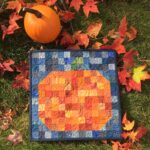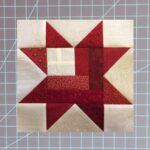This Easter Egg scrappy mini quilt is an easy pattern for a beginning quilter. Measuring just 13” x 14”, the Easter Egg quilt is the perfect size to decorate a shelf or table. Or add a sleeve to the back of the quilt, and hang this Egg up!!
There’s nothing too complicated about the pattern. This quilt can easily be made over the weekend!! Using such small squares, you can either purchase small amounts of fabric or just use scraps to create this egg!
Full directions for this quilt pattern are within this post.
If you’d like to purchase a pdf of this pattern, click here to visit my Etsy shop.
General Sewing Directions
- The directions for this Easter Egg quilt are for rotary cutting, machine piecing, machine quilting, and the binding is hand-stitched to the quilt back.
- Accurate cutting and sewing enhances your final product. Pin your pieces together before sewing them to ensure proper seam alignment.
- Use a ¼” seam allowance. I recommend using a special presser foot with a ¼” guide if you have one for your machine. This will help you get uniform seams, and matching corners!
- Follow the directions described below as you press open the seams. Each individual row is pressed in the opposite direction of the previous row to eliminate bulk and help seams to lay flat. Rows sewn together are then all pressed in one direction for a uniform look.
- The pattern calls for machine quilting, but this quilt is so small you could easily hand quilt it!
- The finished quilt measures 13” x 14”.
- This scrappy, mini Easter Egg quilt is so cute it’ll steal your heart! It takes very little fabric to make this quilt. Carefully read through all the information below on how to create this little scrappy egg!
Fabric Requirements
The egg is created using a variety of colorful prints. For the background I used a variety of buttery cream-colored fabric to show off the egg.
You could also use one pastel color palette for the egg and a spring green or gray for the background. Have fun deciding, and remember…there’s no rules!!

Colorful Egg Fabric:
The total fabric needed is less than ¼ yard. However, to achieve the scrappy look of this quilt I suggest using at least 10 different prints.
Either raid your stash, or purchase a few new fat quarters. You’ll need at least 1 ½” wide strip of any one fabric.
Cream Fabric for Background:
Again, the total fabric needed is less than ¼ yard. However, to achieve the scrappy look of this quilt I suggest using at least 10 different prints.
Either raid your stash, or purchase a few new fat quarters. You’ll need at least 1 ½” wide strip of any one fabric.
Backing Fabric:
1 fat quarter
Binding Fabric:
1/6 yard total
Batting:
You’ll need a piece of 17″ x 18″ thin cotton batting (like Warm & Natural) to make this quilt
Cutting Directions
Egg:
Cut 98- – 1 ½” colored squares. I suggest using at least 8-10 different prints. Either raid your stash, or purchase a few new fat quarters. You will use some of these squares to make unique blocks.
Background:
Cut 106 – 1 ½” cream squares. Again, use a variety of at least 8-10 different prints from your stash or fun new fat quarters. You will use some of these squares to make unique blocks.
Binding:
Cut either 2 – 2 ½” x 44” strips, or cut 4 – 2 ½” x 22” strips, trim the ends of each strip at opposing 45-degree angles as shown here.

Backing:
Cut a 17” x 18” rectangle.
Batting:
Cut a 17″ x 18″ rectangle.
Making the Unique Blocks
There are 6 different unique blocks that you’ll make. Follow these directions to create each of these blocks.
I suggest making all of one unique block before moving onto the next block. This way you will be less likely to get confused when marking and trimming the unique blocks.
Unique Block #1
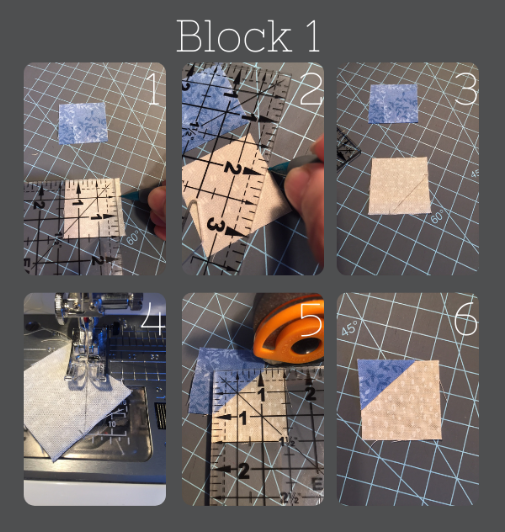
- On the wrong side of a cream square mark a tiny little line ½” down from the upper right corner. Also mark a tiny little line ½” over from the lower left corner (the opposite corner).
- Connect these marks with a straight edge.
- Lay this marked cream square right sides together on a colored square.
- Sew along the diagonal line.
- Open the connected squares. Lay a small ruler over the cream square, as shown, to measure the square to be 1 ½”. Trim the colored part of this block so that it measures 1 ½” square.
- Press the block toward the colored part. Trim the back seam to about ¼”.
- Make 4 of the Block #1.
Unique Block #2

- On the wrong side of a cream square mark a tiny little line ½” down from the upper right corner. Also mark a tiny little line ½” over from the lower left corner (the opposite corner).
- Connect these marks with a straight edge.
- Lay this marked cream square right sides together on a colored square.
- Sew along the diagonal line.
- Open the connected squares. Lay a small ruler over the colored square, as shown, to measure the square to be 1 ½”. Trim the cream part of this block so that it measures 1 ½” square.
- Press the block toward the colored part. Trim the back seam to about ¼”.
- Make 2 of the Block #2.
Unique Block #3
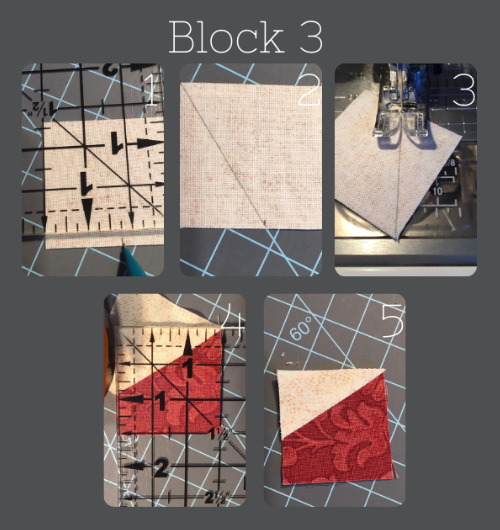
- On the wrong side of a cream square mark a tiny little line 5/8” over from the lower right corner.
- Connect this mark and the upper left corner with a straight edge.
- Lay this marked cream square right sides together on a colored square and sew along the diagonal line.
- Open the connected squares. Lay a small ruler over the colored square, as shown, to measure the square to be 1 ½”. Trim the cream part of this block so that it measures 1 ½” square.
- Press the block toward the colored part. Trim the back seam to about ¼”.
- Make 5 of the Block #3.
Unique Block #4
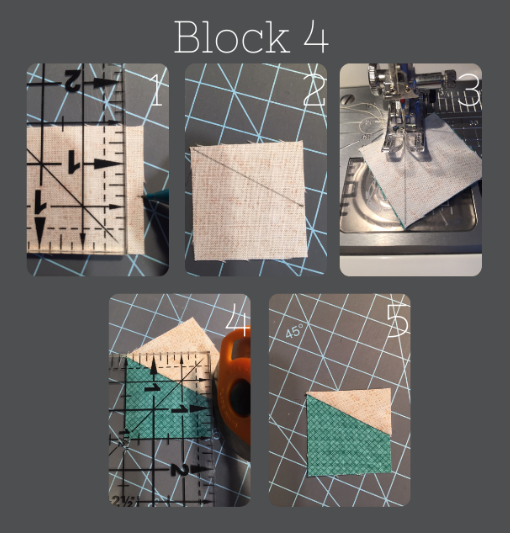
- On the wrong side of a cream square mark a tiny little line 5/8” up from the lower right corner.
- Connect this mark and the upper left corner with a straight edge.
- Lay this marked cream square right sides together on a colored square and sew along the diagonal line.
- Open the connected squares. Lay a small ruler over the colored square, as shown, to measure the square to be 1 ½”. Trim the cream part of this block so that it measures 1 ½” square.
- Press the block toward the colored part. Trim the back seam to about ¼”.
- Make 5 of the Block #4.
Unique Block #5
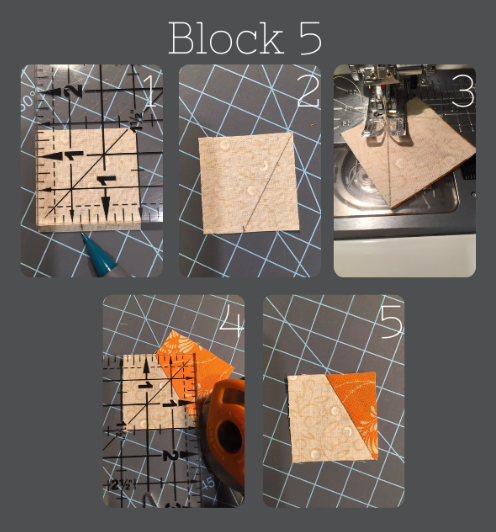
- On the wrong side of a cream square mark a tiny little line 5/8” over from the lower left corner.
- Connect this mark and the upper right corner with a straight edge.
- Lay this marked cream square right sides together on a colored square and sew along the diagonal line.
- Open the connected squares. Lay a small ruler over the cream square, as shown, to measure the square to be 1 ½”. Trim the colored part of this block so that it measures 1 ½” square.
- Press the block toward the colored part. Trim the back seam to about ¼”.
- Make 3 of the Block #5.
Unique Block #6
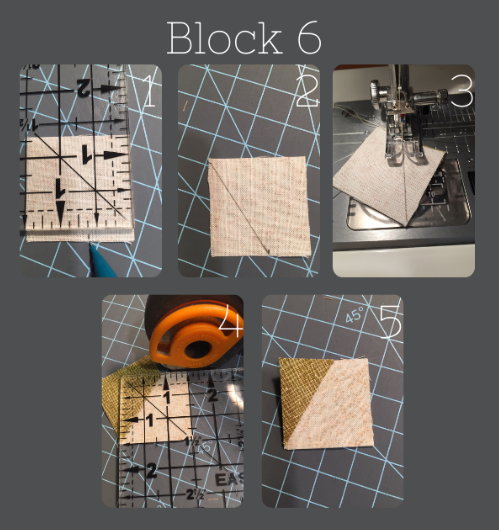
- On the wrong side of a cream square mark a tiny little line 5/8” over from the lower right corner.
- Connect this mark and the upper left corner with a straight edge.
- Lay this marked cream square right sides together on a colored square and sew along the diagonal line.
- Open the connected squares. Lay a small ruler over the cream square, as shown, to measure the square to be 1 ½”. Trim the colored part of this block so that it measures 1 ½” square.
- Press the block toward the colored part. Trim the back seam to about ¼”.
- Make 3 of the Block #6.
Assemble the Quilt Top
Now that you have all your 1 ½” squares cut out and your half square and unique blocks ready, you want to plan how they’ll be arranged to make up the quilt top.

I like to lay all my squares on a card table next to my sewing machine and play with arranging them until I get the look I want.
Follow the Diagram of Block Layout to obtain the shape of the egg. The layout will be 13 squares across and 14 squares down.

The quilt top has 14 rows. Begin stitching squares together (right sides facing) to complete each row.
Remember to use a ¼” seam allowance for all seams. I really like to use my ¼” seam foot to make sure all my seams are exactly ¼”!! This is especially important when sewing such tiny squares together.
If you don’t have this type of foot, make sure you know exactly where your ¼” sewing line is on your machine, and be careful to follow it!
As you complete a row, lay it back down on the table in the right placement to make sure you don’t mess up your arrangement of blocks.
Pressing the Blocks and Rows
- I wait to press the rows until I have each of them sewn together. Be careful to just “press” and NOT “iron” the seams in a back-and-forth motion, or your quilt will stretch out of shape.
- Begin by pressing the seams of the first row all in one direction. Press the seams of the second row in the opposite direction. Continue to rotate the pressing direction of each row until you have the seams of all rows pressed. Think…odd rows 1, 3, 5, etc. press the seams to the right. Even rows 2, 4, 6, etc. press the seams to the left.
- By using this rotating direction of pressed seams, you will have less bulk when you sew the rows to each other. This method of pressing distributes the bulk, which will make you happy when you machine quilt your project! Bulky seams can lead to bumpy quilting patterns, broken thread, and overall unevenness of your machine-quilted quilt top.
- Now that you have the pieced rows pressed, sew them together! Pin rows 1 and 2 together, right sides together. Make sure to line up the seams, and pin to hold them in place. Remove the pins as you come to them when you’re stitching the ¼” seam. I like to press each set of rows as I sew them together. The rows all get pressed in one direction, either towards the top or towards the bottom. By pressing them all in one direction it will make for a more uniform and smooth quilt top. Repeat until you have all of the rows sewn to each other and pressed.
Nicely pressed quilt blocks and tops are a work of art, and a skill to develop! I love how pretty they look from the back too!!
Finishing the Quilt
Now that you have your quilt top sewn together, it’s time to finish it!
Layering the Top, Batting, and Back
I refer to layering the quilt as “sandwiching”. You need to sandwich the top and back with the batting in the middle.
For a larger quilt, this process takes a bit more time and steps. But for this mini quilt, it’s a breeze to sandwich the layers together!

Secure the Backing
On a table or countertop, use masking or painter’s tape to tape down the backing fabric. As you tape the back to the table, you’ll want to make sure the fabric is smooth, without wrinkles. Also, make sure the right side of the fabric is facing down!
Add the Batting
Lay the batting on top of the taped-down quilt back, and move your hands across it to smooth it all over. This will get rid of any wrinkles in the batting, and help to adhere it to the backing fabric. This quilt is so small, you don’t need to use basting spray to adhere the layers together. Just a few pins will do the trick!
Add the Flimsy!
Once you have the batting placed on top of the quilt back, center the top of the quilt (the flimsy!) over the two bottom layers. Right side facing up, of course! The two bottom layers of the quilt (the back and the batting) should extend about 2” all around the outside edges of the quilt top.
Move your hands across the quilt top to smooth it all over, and help remove any wrinkles. This will also help adhere the quilt top to the batting a little bit.
Pin the Layers Together
Once you have the top of the quilt all smoothed out, use large safety pins to baste all three layers together. I like to use 1 ½” stainless pins, and I keep them all in a cute old canning jar that was my grandma’s.
Put a pin in each corner of the quilt sandwich, in the middle, and around the quilt so the three layers don’t move around when you’re machine quilting this project.
I used about 10 pins to hold the sandwich together. You really don’t want to use more than this or you’ll be needing to stop a lot when you’re quilting to remove pins, which upsets the mojo of your quilting rhythm, lol!
“Quilting” the Quilt
I used a circular cinnamon bun pattern to machine quilt my layers together.
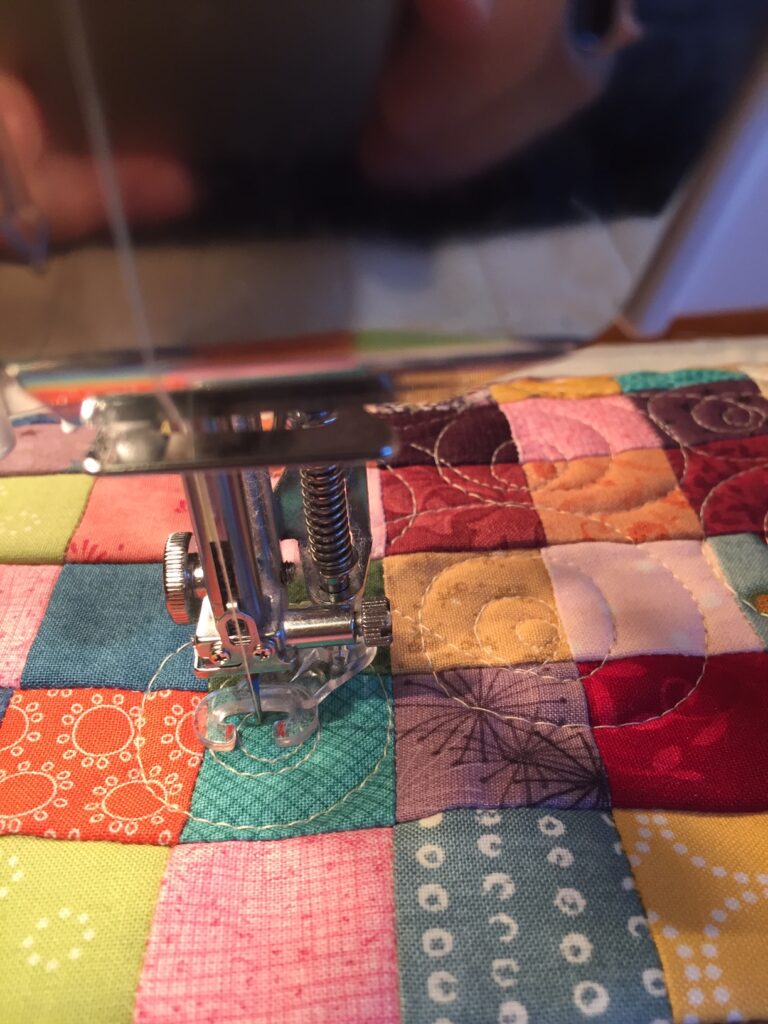
Use whatever free-motion stitch you’d like, or use a straight stitch to quilt in the ditches or along the seams.
You’ll need a darning foot to free-motion quilt, and you’ll need to either be able to lower the feed dogs on the machine or place a special cover over them.
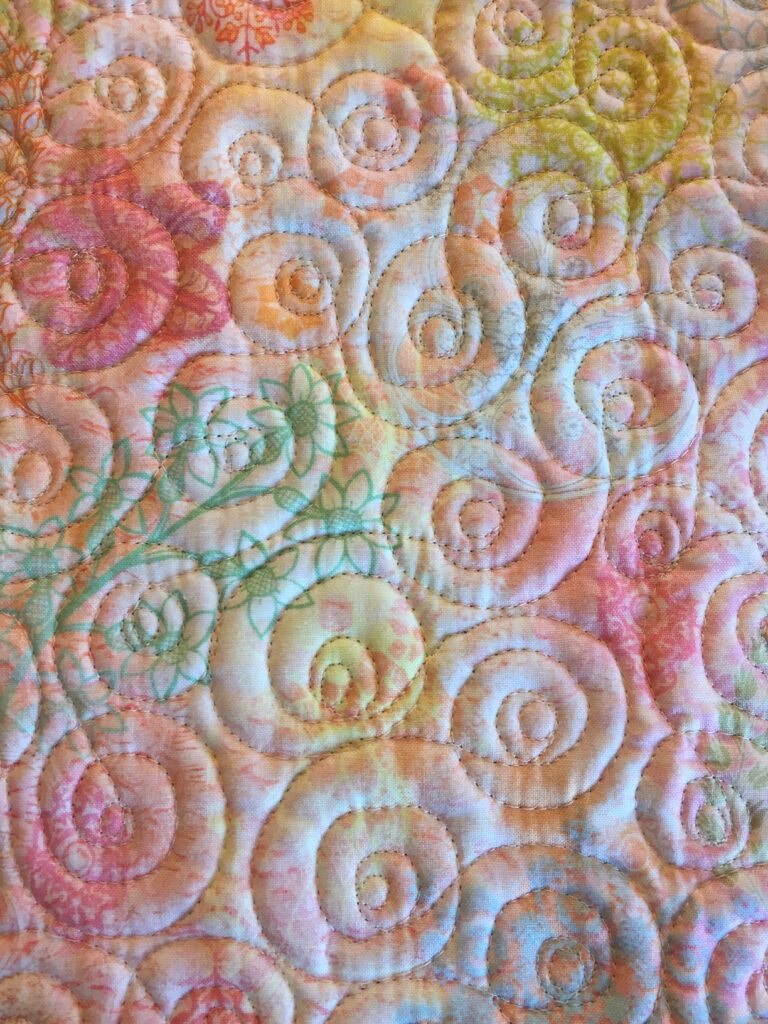
If you’re using a straight stitch to machine quilt you’ll need a walking foot.
As an alternative, you can hand-quilt these layers together too.
Binding the Quilt
When you’ve finished quilting the layers together, it’s time to bind the edges of your quilt!
In my post on the Happy Heart scrappy mini quilt I described the process I use to bind a quilt. Click here if you’d like to read through my process.
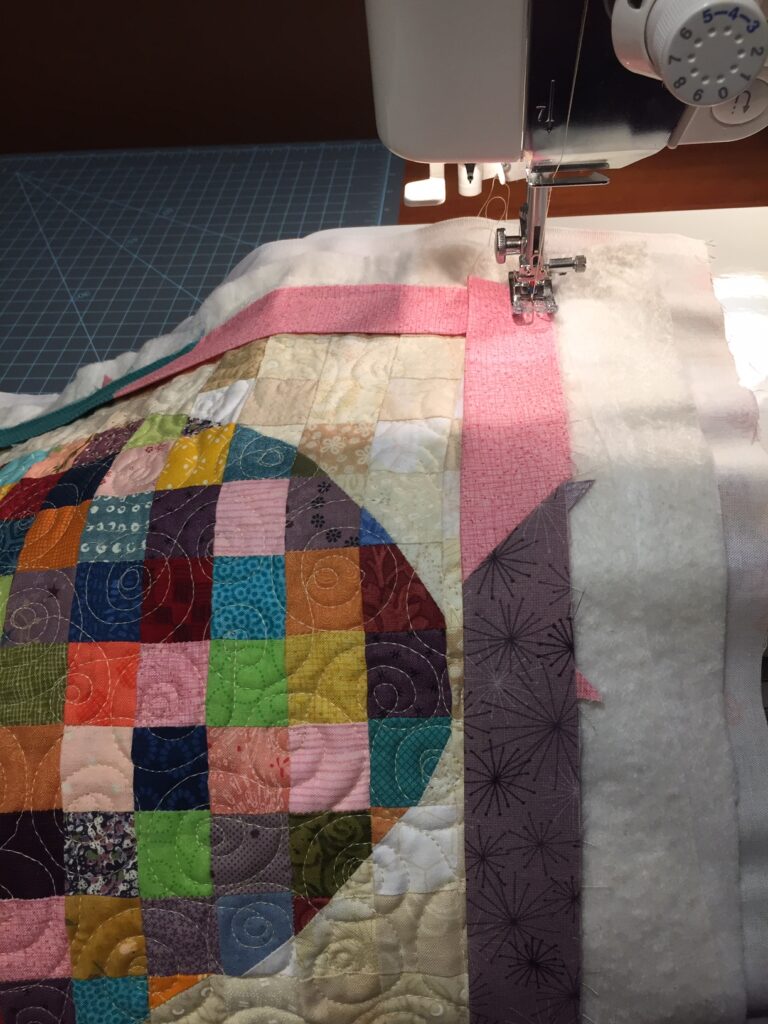
Trim the Batting and Back
Trim the batting and quilt back to ¼” from the edge of the quilt top. I use a ruler and a rotary cutter to accomplish this task. Work carefully, so you don’t cut into your quilted project.

Hand-Stitch the Folded Binding Edge to the Quilt Back
Here is my FAVORITE part of the process, hand-sew the folded edge of the binding strip to the back of the quilt.
When you get to the corner, carefully turn the corner right-side out to make a nice, mitered corner. I tack a few stitches up the corner to hold it in place, and then continue stitching along all sides and corners until…
VOILA! Your binding is complete!
If you’d like, you can add a label to the back of your Easter Egg Quilt.

I hope you enjoy making this scrappy, mini quilt!!
Happy Easter!!!
~Bonnie




